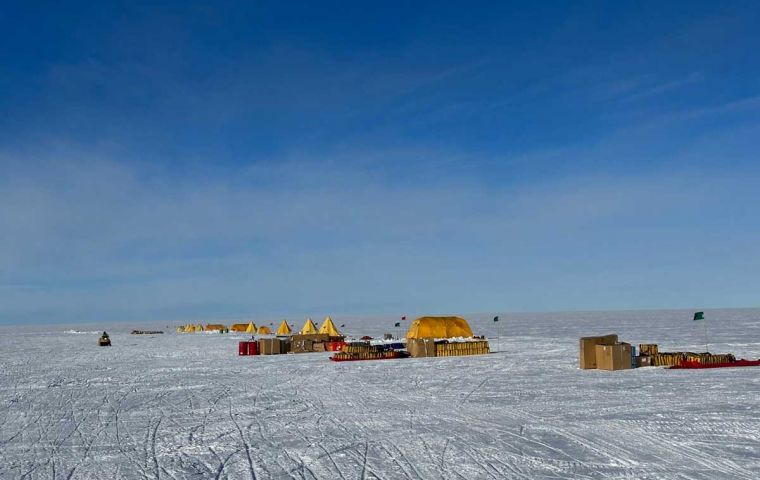MercoPress. South Atlantic News Agency
Scientific teams conclude summer studies at Antarctica’s giant Thwaites Glacier
 A field camp at T2 on Thwaites Glacier. Pic Marianne Karplus.
A field camp at T2 on Thwaites Glacier. Pic Marianne Karplus. Teams of scientists and support staff with the International Thwaites Glacier Collaboration, (ITGC) have spent the past couple of months working on the Thwaites Glacier to advance our knowledge of how it interacts with the ocean and climate, and improve the predictions of its future contributions to sea level rise.
A BAS report indicates the glacier is extremely remote; the study sites on the glacier are more than 1,600 kilometers away from both the British Antarctic Survey’s Rothera Research Station and the US Antarctic Program’s McMurdo Station. Getting teams to the field sites involved transferring people and equipment through multiple camps, using specialized tractors (called a traverse) and several different types of aircraft.
This season the fieldwork was completed by two of ITGC’s eight research projects – Thwaites Interdisciplinary Margin Evolution (TIME) and Geophysical Habitat of Subglacial Thwaites (GHOST). These projects are aimed at understanding the central portions of the glacier, and how it will evolve in future centuries. Earlier work concentrated on the coastal areas, where rapid change has begun and is accelerating.
Bad weather and other logistical problems delayed the TIME and GHOST teams getting into the field by a couple of weeks, and by mid-December, most researchers had made it to a camp called West Antarctic Ice Sheet Divide – a hub at 1800 m elevation on the ice-sheet plateau. From there they headed deeper into the field, fanning out across the upper parts of Thwaites Glacier.
The GHOST team mapped ice and bedrock structure, focusing on the lower reaches of Thwaites, upstream of the critical zone where the glacier comes afloat onto the ocean. Seismic, radar and electromagnetic measurements were made. Results from these unique data sets, combined with computer models, will help us understand the future response of Thwaites Glacier and its potential contribution to sea level rise.
The TIME team were investigating physical properties of the ice and bedrock at the edge of Thwaites Glacier, where the movement of the ice shifts from faster flowing on the glacier to slower moving off the edge of the glacier. Fifteen scientists and support staff completed seismic surveys as well as GPS and radar measurements.
Ted Scambos, senior research scientist at University of Colorado, the lead US scientist in the ITGC Science Coordination Office (SCO), says: “It’s been a tremendous effort by all of the groups and the supporting work from BAS and USAP – and overall it’s been a huge success. Thwaites was mystery when we began. Now we have a real basis for understanding its changes and its future.”
Dr Robert Larter, senior marine geophysicist at British Antarctic Survey (BAS), the lead UK scientist in the SCO, says: “This season of fieldwork is a huge milestone, marking the end of five years of ambitious research. A project of this scale is only possible with teamwork, problem-solving and collaboration and we’ve made some incredible discoveries along the way. The end of the fieldwork doesn’t mean the end of the project and we’re excited to investigate the results of this final season’s efforts.”




Top Comments
Disclaimer & comment rulesCommenting for this story is now closed.
If you have a Facebook account, become a fan and comment on our Facebook Page!